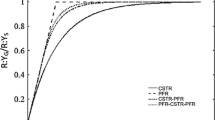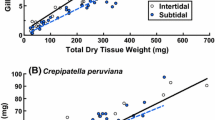Abstract
Pseudopolydora paucibranchiata Okuda suspension feeds and deposit feeds at the sediment-water interface, where it is exposed to a variety of particles differing in physical characteristics and nutritional value. In flume experiments (conducted in August 1994 and May 1995) with two sizes of either suspended or deposited beads, I measured particle-size selection separately in each feeding mode. The same influences of palp width and of ambient flow speed were observed in each mode. At velocities ≤0.74 cm s-1 there were no relationships between palp width and the proportion of gut contents composed of large beads. At velocities ≥1.8 cm s-1 worms with narrower palps ingested relatively fewer large beads (and more small beads) than did worms with wider palps. Palp width and body length were linearly related, and results were similar when analyzed with body length as the independent variable. As flow speed increased, selectivity changed in a worm-size-specific manner: worms with a palp width <ca. 150 μm (or body length <ca. 12 mm) ingested relatively fewer large beads (and more small beads) as velocity rose, while the proportion of large beads ingested by larger worms remained generally constant. These results are most likely explained by mechanics of particle capture. Furthermore, when deposit feeding, worms of all sizes were biased toward ingesting small beads. In contrast, when suspension feeding, worms were biased toward ingesting large beads, with the exception that worms with a palp width <125 μm (or body length <8 mm) were biased for small beads in flows ≥4.0 cm s-1. Assuming that in the field (1) particle size is the principle criterion for selection, and (2) the amount of digestible food component in deposited and suspended particles, respectively, is related to particle surface area and volume, I hypothesize that changes in selectivity as velocity rises can cause juveniles to experience a decreasing profitability of suspension feeding and a simultaneously increasing profitability of deposit feeding. Juveniles could maintain a diet of high food value despite flow variations by adjusting the proportion of time they spend suspension feeding relative to deposit feeding.
Similar content being viewed by others
References
Conover WJ (1980) Practical nonparametric statistics. (2nd edn) John Wiley and Sons, New York
Dauer DM, Maybury CA, Ewing RM (1981) Feeding behavior and general ecology of several spionid polychaetes from the Chesapeake Bay. J exp mar Biol Ecol 54: 21–38
Gross TF, Nowell ARM (1983) Mean flow and turbulence scaling in a tidal boundary layer. Contin Shelf Res 2: 109–126
Hentschel BT (1996) Ontogenetic changes in particle-size selection by deposit-feeding spionid polychaetes: the influence of palp size on particle contact. J exp mar Biol Ecol (in press)
Hentschel BT, Jumars PA (1994) In situ chemical inhibition of benthic diatom growth affects recruitment of competing, permanent and temporary meiofauna. Limnol Oceanogr 39: 816–838
Johnson AS (1988) Hydrodynamic study of the functional morphology of the benthic suspension feeder Phoronopsis viridis (Phoronida). Mar Biol 100: 117–126
Jumars PA (1993) Gourmands of mud: diet choice in deposit feeders. In: Hughes RN (ed) Mechanisms of diet choice. Blackwell, Oxford, pp 136–168
Jumars PA, Nowell ARM (1984) Fluid and sediment dynamic effects on marine benthic community structure. Am Zool 24: 45–55
Jumars PA, Self RFL, Nowell ARM (1982) Mechanics of particle selection by tentaculate deposit-feeders. J exp mar Biol Ecol 64: 47–70
LaBarbera M (1984) Feeding currents and particle capture mechanisms in suspension feeding animals. Am Zool 24: 71–84
Lehman JT (1976) The filter-feeder as an optimal forager, and the predicted shapes of feeding curves. Limnol Oceanogr 21: 501–516
Levin LA (1981) Dispersion feeding behavior and competition in two spionid polychaetes. J mar Res 39: 99–117
Levin LA (1982) Interference interactions among tube-dwelling polychaetes in a dense infaunal assemblage. J exp mar Biol Ecol 65: 107–119
Luckenbach MW, Huggett DV, Zobrist EC (1988) Sediment transport, biotic modifications and selection of grain size in a surface deposit-feeder. Estuaries 11: 134–139
Miller DC, Bock MJ, Turner EJ (1992) Deposit and suspension feeding in oscillatory flows and sediment fluxes. J mar Res 50: 489–520
Montagnes DJS, Berges JA, Harrison PJ, Taylor FJR (1994) Estimating carbon, nitrogen, protein, and chlorophyll a from volume in marine phytoplankton. Limnol Oceanogr 39: 1044–1060
Muschenheim DK (1987) The role of hydrodynamic sorting of seston in the nutrition of a benthic suspension feeder, Spio setosa (Polychaeta: Spionidae). Biol Oceanogr (NY) 4: 265–288
Nicol EAT (1930) The feeding mechanism, formation of the tube, and physiology of digestion in Sabella pavonina. Trans R Soc Edinb 56: 537–598
Nowell ARM, Jumars PA (1984) Flow environments of aquatic benthos. A Rev Ecol Syst 15: 303–328
Nowell ARM, Jumars PA (1987) Flumes: theoretical and experimental considerations for simulation of benthic environments. Oceanogr mar Biol A Rev 25: 91–112
Okamura B (1990a) Behavioural plasticity in the suspension feeding of benthic animals. In: Hughes RN (ed) Behavioural mechanisms of food selection. Springer-Verlag, Berlin, pp 637–660
Okamura B (1990b) Particle size, flow velocity, and suspension-feeding by the erect bryozoans Bugula neritina and B. stolonifera. Mar Biol 105: 33–38
Ronan TE (1978) Food-resources and the influence of spatial pattern on feeding in the phoronid Phoronopsis viridis. Biol Bull mar biol Lab, Woods Hole 154: 472–484
Rubenstein DI, Koehl MAR (1977) The mechanisms of filter feeding: some theoretical considerations. Am Nat 111: 981–994
Sebens KP, Koehl MAR (1984) Predation on zooplankton by the benthic anthozoans Alcyonium siderium (Alcyonacea) and Metridium senile (Actinaria) in the New England subtida. Mar Biol 81: 255–271
Self RFL, Jumars PA (1988) Cross-phyletic patterns of particle selection by deposit feeders. J mar Res 46: 119–143
Shimeta J (1993) Diffusional encounter of submicrometer particles and small cells by suspension feeders. Limnol Oceanogr 38: 456–465
Shimeta J, Jumars PA (1991) Physical mechanisms and rates of particle capture by suspension-feeders. Oceanogr mar Biol A Rev 29: 191–257
Shimeta J, Koehl MAR (1996) Mechanisms of particle selection by tentaculate suspension feeders during encounter, retention, and handling. J exp mar Biol Ecol (in press)
Sokal RR, Rohlf FJ (1995) Biometry. (3rd edn) W.H. Freeman and Company, New York
Taghon GL (1982) Optimal foraging by deposit-feeding invertebrates: roles of particle size and organic coating. Oecologia 52: 295–304
Taghon GL, Greene RR (1992) Utilization of deposited and suspended particulate matter by benthic “interface” feeders. Limnol Oceanogr 37: 1370–1391
Taghon GL, Nowell ARM, Jumars PA (1980) Induction of suspension feeding in spionid polychaetes by high particulate fluxes. Science, NY 210: 562–564
Taghon GL, Self RFL, Jumars PA (1978) Predicting particle selection by deposit feeders: a model and its implications. Limnol Oceanogr 23: 752–759
Vogel S (1994) Life in moving fluids: the physical biology of flow. (2nd edn). Princeton University Press, Princeton
Weinberg JR (1979) Ecological determinants of spionid distributions within dense patches of deposit-feeding polychaete Axiothella rubrocincta. Mar Ecol Prog Ser 1: 301–314
Whitlatch RB (1980) Patterns of resource utilization and coexistence in marine intertidal deposit feeders. J mar Res 38: 743–765
Whitlatch RB (1989) On some mechanistic approaches to the study of deposit feeding in polychaetes. In: Lopez G, Taghon G, Levinton J (eds) Ecology of marine deposit feeders. Springer-Verlag, New York, pp 291–308
Whitlatch RB, Weinberg JR (1982) Factors influencing particle selection and feeding rate in the polychaete Cistenides (Pectinaria) gouldii. Mar Biol 71: 33–40
Author information
Authors and Affiliations
Additional information
Communicated by J. P. Grassle, New Brunswick
Rights and permissions
About this article
Cite this article
Shimeta, J. Particle-size selection by Pseudopolydora paucibranchiata (Polychaeta: Spionidae) in suspension feeding and in deposit feeding: influences of ontogeny and flow speed. Marine Biology 126, 479–488 (1996). https://doi.org/10.1007/BF00354630
Received:
Accepted:
Issue Date:
DOI: https://doi.org/10.1007/BF00354630




